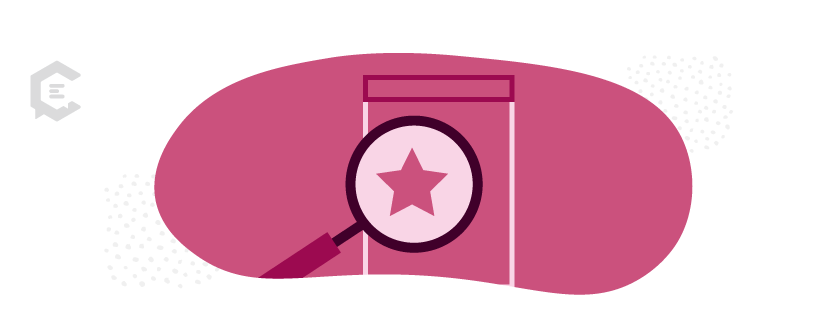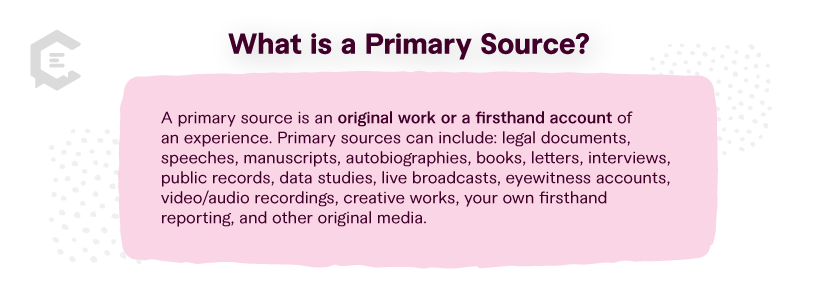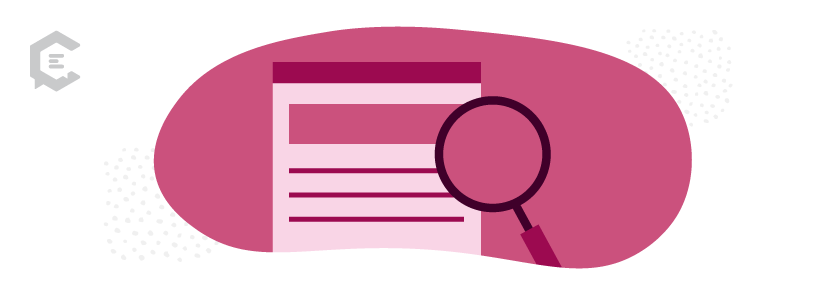Primary vs. secondary sources: What’s the difference? In general, primary sources are original works or firsthand accounts of experiences, while secondary sources are analysis, interpretation, or opinion about or based upon a primary source or sources.
Building rapport founded on trust is paramount when nurturing a relationship with your audience. One key pillar of this approach includes offering insightful, credible information that equally informs and inspires readers to take action or think more critically about a topic. As a writer, how do you manifest such performance-driven content?
The quick answer: You rely on sources.
Journalism school professors drive home the importance of finding, using, and citing quality sources to enrich reporting and establish authority with readers. This textbook journalism mainstay also serves the content marketing community well since both parties strive to engage and educate readers with thoughtful, trustworthy content.
How you vet, cite, and use sources matters.
Why you should care about sourcing
Journalists should take responsibility for the accuracy of their work. Verify information before releasing it. Use original sources whenever possible. Identify sources clearly. The public is entitled to as much information as possible to judge the reliability and motivations of sources. — Society of Professional Journalists Code of Ethics
Brands are experts in their respective fields. But to authentically bolster your thought leadership and win over new consumers, it behooves you to dig deep and give your readers information that has depth beyond basic details or opinionated musings.
Savvy readers want concrete, fact-based information that helps them make a decision or solve a problem. Well-sourced content can do exactly that. Researchers rely on primary and secondary sources to add that credibility oomph every editor wants to see in the words they polish for content marketing clients. This is why guidelines on sourcing should be a part of your editorial style guide.
What is a primary source?
A primary source is an original work or a firsthand account of an experience.
What are primary sources in content marketing?
When you’re not sharing a personal thought or idea (which should be clearly marked as an opinion for your readers), turn to primary sources.
These are original works or firsthand accounts of experiences and discoveries such as:
- A speech you listen to
- An interview you conduct
- Legal documents and public records
- Autobiographical books, research reports, and other published works
Not all primary sources are created equal. If they appear to be constructed with pieces of information stemming from a variety of external sources, they may actually be a secondary source, which we’ll explore shortly.
For example, think of a book you’ve read with an extensive bibliography. The bulk of the prose is based on interviews and the research of others, with very little input from the author beyond synthesizing information from others. That book is a secondary source.
Sourcing can become a slippery slope of information. When in doubt, primary sources provide original, first-time-created information stemming from credentials, whether they’re educational degrees, original research, or firsthand experiences.
Examples of primary sources
As an example, say you’re a writer in the health and wellness niches, so you rely on primary sources to fuel blog posts and ebooks relating to the latest developments and discoveries in everything from vegan sources of protein to how meditation physically affects our brains. You’re a writer by trade, not a physician or dietician, so you turn to credible sources to enhance the content you create.
A few reputable examples of primary sources you might use include the following:
The American Journal of Medicine: This is a peer-reviewed publication from the Alliance for Academic Internal Medicine that represents medical schools and teaching hospitals across the United States and Canada. The information they share comes directly from research labs, published studies, and niche experts in the medical field, so you know you’re curating the most insightful, original data you can as a researcher.
Help a Reporter Out: For some of your work, you might want to conduct interviews to get firsthand information. Help a Reporter Out (HARO) can help you locate primary sources to vet, then interview.
Mayo Clinic: This non-profit organization focuses on practicing, educating, and researching the most serious, complex illnesses affecting humans. Their website is a treasure trove of educational and research documents created by their physicians and medical research faculty based on clinical trials and firsthand research.
Primary sources can also include customers, senior executives in an organization, or researchers a brand partners with to create a product or service. Lean into these options when crafting case studies, customer testimonials, or first-person accounts for your audience.
What is a secondary source?
A secondary source is an analysis, interpretation, or opinion about (or based upon) a primary source.
What are secondary sources in content marketing?
With ample primary sources available, it’s no surprise that people with a vested interest in the topics discussed by experts weigh in with their opinions and perspectives. Although they didn’t create the original insight, they can often lend a perspective that gives others a new idea or additional information to consider.
Simply put, secondary sources build upon primary sources through analysis and interpretation.
Here are a few examples of secondary sources:
- An editorial column or blog post
- A newspaper, newsletter, or magazine article
- Commentary via podcast, vlog, blog post, or other digital media
Examples of secondary sources
Let’s dive into a few examples of secondary sources that offer fresh ideas about marketing by parsing information gathered from trusted primary sources.
MarketingProfs
Ann Handley and her team of marketing pros offer an online resource library of articles, courses, reports, infographics, podcasts, video tutorials, webinars, and more with the sole purpose of breaking down the latest and most interesting happenings in the world of content marketing. They do this by analyzing data and insights created by primary sources in this niche.
In this MarketingProfs article, “7 Strategies for Creating Emails That Stand out,” the author gleaned insight from Statista (original research) about email habits. The insights were then parlayed into email marketing trends and tactics that content marketers might find useful when focusing on increasing engagement rates and meeting campaign benchmarks.
Semrush
In addition to its suite of marketing services, Semrush maintains an online community nurtured with blog posts, webinars, ebooks, and games to polish users’ marketing skills. These secondary sources are packed with primary sources that savvy marketing professionals instantly connect with and trust.
This webinar from SEMrush, ‘SEO Predictions 2020 (Australia)’, features the thoughts and ideas from a panel of search marketers based on the information they’ve absorbed, gathered, and tested over the years. This discussion bubbles up ideas based on their firsthand experiences, creating a solidly-backed secondary source infused with primary source insight.
How do you evaluate and reference sources?
Now that you know the difference between primary versus secondary sources, let’s talk about evaluating them. Say you found a few sources for your next project. At a cursory glance, they seem like a good fit and have interesting information to share. But, are they the best choice when creating a content marketing document? Do they radiate authority? Are their credentials real? Do they align with your brand’s values? Let the vetting process begin!
Choosing potential primary sources
All information comes from somewhere. As a savvy content creator, you’re used to asking where. Now you need to go a step further and look at the credibility of the source. How did they get the information they are sharing? Do they have extensive hands-on experience with the topic? Or, maybe they studied the topic in college, have written a book based on their research, or speak publicly about the topic to educate others.
As you vet your potential sources, think about why the information they can add to your content is going to make an impact. It usually boils down to professional training, experience, or education on a topic.
Now go another step further and verify that the credentials they share in their bios are indeed true. Consider cross-referencing their LinkedIn profile, looking up the book they say they wrote, or viewing a YouTube video of one of their presentations.
Does everything align? They are most likely credible sources.
When you then move into the writing phase, let your readers know why you chose the sources you did. Include their job titles, accolades, and achievements. You need to sell your audience on the source’s authority in a few sentences, so be concise.
Citing and crediting your sources
Backing up the information you share requires more than attaching a name and job title to the quote or stat. Plus, there are subtle nuances for primary and secondary source accreditation.
Primary source: When someone shares original information, they deserve credit. In addition to stating their name and business title, a blurb about what makes them authoritative in relation to the topic you’re writing about carries extra weight.
Imagine you want to interview someone about how entrepreneurs can outsource some of their work tasks. An ideal primary source is a business owner (just like the article’s intended audience) who shares how they personally tackled a work challenge by outsourcing content, which is a key point in the article.
Here’s how you would credit them: “[Insert direct quote here],” says First Name Last Name, business owner of We Outsource Productions and two-time Entrepreneur of the Year award winner.
Secondary source: When you come across an analysis piece that refers to intriguing studies, conversations from a television broadcast, or a quote from a research paper, you need to provide a citation. Although well-written and authoritative, that analysis piece isn’t a primary source. It’s a secondary source filled with references to primary sources.
Be diligent and track down the primary sources referenced in the analysis piece and link back to them when you refer to the information you’ve discovered. Credit belongs to the primary source, not the secondary person synthesizing the information.
If the primary sourcing is unclear, give the readers what you do know, such as “according to reporting from The New York Times” or “as discussed on the XYZ Podcast.” Never leave a reader wondering where persuasive, pertinent information came from. Source it!
Gathering information: primary vs. secondary sources
Using primary sources
When speaking with a primary source, always disclose the reason for your conversation and that information gleaned may be used in a published piece of content. If you’re recording the conversation, observe federal and state laws regarding electronic recording equipment, including cell phone apps and video chat features. It’s beneficial to review 18 U.S. Code Chapter 119 —Wire and Electronic Communications Interception and Interception of Oral Communications.
And always ask for the person’s full name, spelled out by them. Never make assumptions, because even a common name like Stacy, Stacey, Staci, Stacee, and Stayce can be spelled in a variety of ways.
Using secondary sources
When it comes to secondary sources, be mindful of copyright and usage laws regulated by the Federal Communications Commission (FCC). Just because a document is made public doesn’t mean you can simply cut and paste it into your article. Familiarize yourself with these regulations.
- Copyright Law: This governs how copyright owners control the distribution and reproductions of their creative, original works. In short, sharing a few sentences is acceptable when it’s properly attributed to the creator. This is usually done online with a backlink embedded in the title of the work referenced.
- Rights of Publicity: This refers to the rights of an individual (often a public figure) and how their name, image, and likeness can be used. It’s also referred to as Rights of Privacy. Know this: Linking a famous person to a product campaign may be an unlawful attempt at creating a product endorsement.
- Fair Use Doctrine: This U.S. Copyright statute allows content creators to use a limited portion of a work, such as quotes, for the purpose of creating commentary, news reports, or academic papers. Again, proper attribution to the original source is always necessary.
The sharing of information connects us with others. Brands are no strangers to the benefits of maintaining a regular blogging cycle or offering a warm lead of a complimentary ebook to help solve a concern.
Want to Outsource Your Sourcing?
As a writer or person in charge of hiring the writer, you need to ensure your content marketing pieces feature quality information from trustworthy sources presented in a way that readers will consume without second-guessing the validity.
If that sounds like something you’d rather not worry about, ClearVoice has got you covered. Our expert teams can help you produce content with high-quality sources that bolster your brand authority and credibility. Talk to a specialist today to see how.










